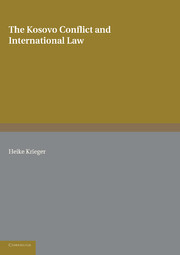Book contents
- Frontmatter
- Contents
- Map
- Preface
- Chronology
- Introduction
- Chapter 1 Kosovo's Status in Yugoslavia before 1999
- Chapter 2 Development of the Human Rights Situation pages 14 to 40
- Chapter 2 Development of the Human Rights Situation pages 41 to 64
- Chapter 2 Development of the Human Rights Situation pages 65 to 90
- Chapter 2 Development of the Human Rights Situation pages 90 to 114
- Chapter 3 Diplomatic Efforts for the Settlement of the Crisis pages 115 to 146
- Chapter 3 Diplomatic Efforts for the Settlement of the Crisis pages 147 to 187
- Chapter 3 Diplomatic Efforts for the Settlement of the Crisis pages 187 to 217
- Chapter 3 Diplomatic Efforts for the Settlement of the Crisis pages 218 to 253
- Chapter 3 Diplomatic Efforts for the Settlement of the Crisis pages 253 to 286
- Chapter 4 Military Action against Yugoslavia pages 287 to 313
- Chapter 4 Military Action against Yugoslavia pages 314 to 352
- Chapter 5 Settlement of the Crisis
- Chapter 6 Statement by NATO Memeber States
- Chapter 7 International Reactions to the Crisis pages 424 to 460
- Chapter 7 International Reactions to the Crisis pages 461 to 499
- Chapter 8 Court Action with regard to the Kosovo Crisis
- Chapter 9 Implementation of the Principles for a Political Solution of the Conflict
- Chronological List of Documents
- Select Bibliography
- Index
Chapter 2 - Development of the Human Rights Situation pages 65 to 90
Published online by Cambridge University Press: 05 July 2014
- Frontmatter
- Contents
- Map
- Preface
- Chronology
- Introduction
- Chapter 1 Kosovo's Status in Yugoslavia before 1999
- Chapter 2 Development of the Human Rights Situation pages 14 to 40
- Chapter 2 Development of the Human Rights Situation pages 41 to 64
- Chapter 2 Development of the Human Rights Situation pages 65 to 90
- Chapter 2 Development of the Human Rights Situation pages 90 to 114
- Chapter 3 Diplomatic Efforts for the Settlement of the Crisis pages 115 to 146
- Chapter 3 Diplomatic Efforts for the Settlement of the Crisis pages 147 to 187
- Chapter 3 Diplomatic Efforts for the Settlement of the Crisis pages 187 to 217
- Chapter 3 Diplomatic Efforts for the Settlement of the Crisis pages 218 to 253
- Chapter 3 Diplomatic Efforts for the Settlement of the Crisis pages 253 to 286
- Chapter 4 Military Action against Yugoslavia pages 287 to 313
- Chapter 4 Military Action against Yugoslavia pages 314 to 352
- Chapter 5 Settlement of the Crisis
- Chapter 6 Statement by NATO Memeber States
- Chapter 7 International Reactions to the Crisis pages 424 to 460
- Chapter 7 International Reactions to the Crisis pages 461 to 499
- Chapter 8 Court Action with regard to the Kosovo Crisis
- Chapter 9 Implementation of the Principles for a Political Solution of the Conflict
- Chronological List of Documents
- Select Bibliography
- Index
Summary
THE UN HIGH COMMISSIONER FOR REFUGEES (UNHCR)
41. UNHCR Country Updates – Former Yugoslavia: 24 February 1999 – 4 March 1999, UN Inter-Agency Humanitarian Situation Report: Kosovo Population Movements
1. The most recent displacement is along Kosovo's Southeastern region bordering the former Yugoslav Republic of Macedonia an area previously unaffected by violence. To date UNHCR reports that more than 5,000 people have fled six villages in this area. On 2 March UNHCR brought plastic sheeting, sleeping bags, blankets, hygienic kits and canned food to 250 displaced staying in a school in Kacanik town. The displaced had previously been evacuated by UNHCR after spending two days under plastic sheeting in the mountains.
2. On 3 March UNHCR saw about 200 IDPs living rough on a mountainside at Kodra Ljacit. They had been there five days, fearing fighting between security forces and the Kosovo Liberation Army. UNHCR brought food for the these IDPs (mostly women, children and elderly) who on 26 February fled from their homes at nearby Pustenik, a village of about 600.
3. Elsewhere, UNHCR staff said on 3 March that they continued to hear shelling and gunfire overnight in the Vucitrn region. More than 11,000 people left their homes there after fighting broke out two weeks ago. Some 1,500 residents of Prcevo near Klina fled their homes at 03:00h 2 March when troops conducted military exercises there, but returned to their houses six hours later after troops withdrew.
- Type
- Chapter
- Information
- The Kosovo Conflict and International LawAn Analytical Documentation 1974–1999, pp. 65 - 90Publisher: Cambridge University PressPrint publication year: 2001



